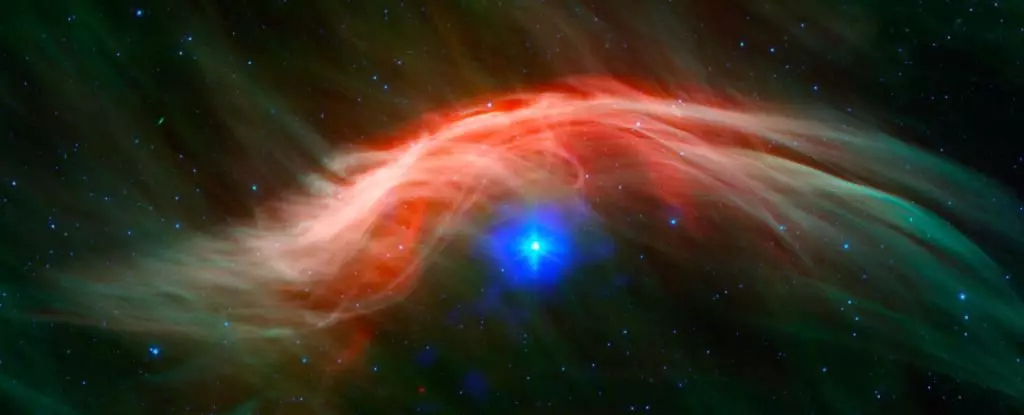The intricate tapestry of life on Earth is shaped by myriad factors, some of which may seem utterly distant. A recent study sheds light on the profound, though indirect, effects that cosmic events, particularly supernova explosions, may have on biological evolution. The research led by astrophysicist Caitlyn Nojiri from the University of California, Santa Cruz, presents compelling evidence linking a significant increase in virus diversity in Lake Tanganyika, Africa, 2.5 million years ago, to the radiative fallout from a supernova. This tantalizing connection poses intriguing questions about the interconnectedness of cosmic phenomena and biological evolution beneath the sunlit skies of our planet.
Supernovae, the explosive deaths of massive stars, serve as celestial forges, producing various elements—some fundamental to life itself. These explosions release a barrage of cosmic rays that permeate space, potentially influencing conditions on nearby planets. Earth occupies a location referred to as the Local Bubble, a stellar nursery shaped by countless supernova activities over millennia. As stellar remnants and debris entwine with solar winds, the bubble’s dynamics could have empowered the evolutionary mechanisms thriving in Earth’s ecosystems.
In the study of Nojiri and her team, they delve into core samples retrieved from Lake Tanganyika, allowing them to analyze sediment deposition over millions of years. Central to their findings is iron-60, a radioactive isotope produced exclusively in supernova events. The presence of this isotope would indicate past supernovae’s proximity and intensity, leading the researchers to pinpoint key moments when Earth experienced heightened exposure to cosmic radiation.
The team’s groundbreaking focus on iron-60 not only detects where and when these cosmic events occurred but also posits a direct influence on the evolution of Earth’s life forms. The notable spikes in iron-60 discovered in the sediment samples offer a timeframe for the cosmic events that coincided with changes in biological diversity. The earlier spike lends itself to the entry of Earth into the Local Bubble, contrasted closely with another spike deciphered to have occurred 2–3 million years ago, likely linked to a supernova from the nearby Scorpius-Centaurus group or Tucana-Horologium.
What makes these findings particularly compelling is the sheer amount of cosmic radiation Earth would have endured following these stellar explosions. Simulations suggest a bombardment of high-energy particles lasting approximately 100,000 years. The calculated dosages of radiation present a striking concern. When gauged, the doses measured could have far-reaching implications for terrestrial life, especially concerning biological evolution driven by environmental pressures.
Radiation—an omnipresent agent in the evolutionary narrative—can exert profound pressures on genetic material. While organisms evolve through various methods, including mutation and natural selection, external factors like radiation add additional layers of complexity. Previous research indicates that even low levels of radiation can disrupt DNA structures, presenting challenges for species adapting to environmental changes.
In particular, Nojiri’s findings suggest a potential link between increased radiation levels during the supernova’s aftermath and the unexpected diversification of viral species in Lake Tanganyika. Although the connection remains ambiguous—causation must not be hastily established—the synchronicity of events provides fertile ground for dialog among evolutionary biologists and astrophysicists alike. Such fluctuations in genetic variety could inspire significant changes in microbial life, rippling through ecosystems over time.
The latest research by Nojiri and her colleagues encourages us to reconsider the separateness we often attribute to cosmic events and the biological processes here on Earth. The implications of her findings underscore the cascading effects that far-off supernovae might have on terrestrial biospheres. As we investigate the effects of celestial phenomena, the intimate interplay emanating from such distant forces invites awe and curiosity.
Following the echoes of Carl Sagan’s musings, as human beings, we are undeniably tied to the stars, both in origin and influence. This acknowledgment compels humanity to maintain a broader perspective, recognizing that events in the cosmos reach beyond scientific abstraction, influencing life in ways that remain vastly unexplored. Perhaps each moment of evolutionary significance, be it grand or subtle, resonates with the rhythm of the universe itself, reminding us of the profound connections we share with the cosmos.

